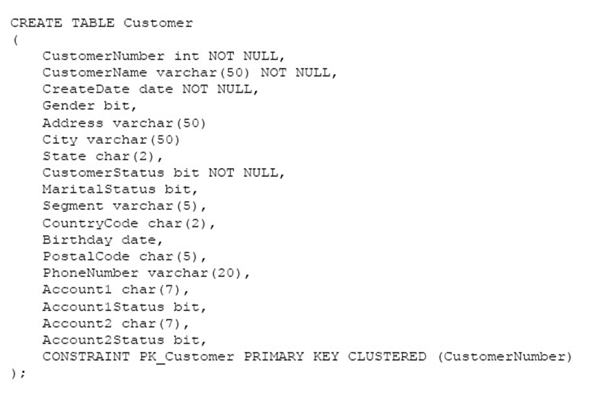

Note: This question is part of a series of questions that use the same scenario. For your convenience, the scenario is repeated in each question. Each question presents a different goal and answer choices, but the text of the scenario is exactly the same in each question in this series.
You have a database named DB1 that contains the following tables: Customer, CustomerToAccountBridge, and CustomerDetails. The three tables are part of the
Sales schema. The database also contains a schema named Website. You create the Customer table by running the following Transact-SQL statement:
The value of the CustomerStatus column is equal to one for active customers. The value of the Account1Status and Account2Status columns are equal to one for active accounts. The following table displays selected columns and rows from the Customer table.
You plan to create a view named Website.Customer and a view named Sales.FemaleCustomers.
Website.Customer must meet the following requirements:
✑ Allow users access to the CustomerName and CustomerNumber columns for active customers.
✑ Allow changes to the columns that the view references. Modified data must be visible through the view.
✑ Prevent the view from being published as part of Microsoft SQL Server replication.
Sales.Female.Customers must meet the following requirements:
✑ Allow users access to the CustomerName, Address, City, State and PostalCode columns.
✑ Prevent changes to the columns that the view references.
✑ Only allow updates through the views that adhere to the view filter.
You have the following stored procedures: spDeleteCustAcctRelationship and spUpdateCustomerSummary. The spUpdateCustomerSummary stored procedure was created by running the following Transacr-SQL statement:
You run the uspUpdateCustomerSummary stored procedure to make changes to customer account summaries. Other stored procedures call the spDeleteCustAcctRelationship to delete records from the CustomerToAccountBridge table.
When you start uspUpdateCustomerSummary, there are no active transactions. The procedure fails at the second update statement due to a CHECK constraint violation on the TotalDepositAccountCount column.
What is the impact of the stored procedure on the CustomerDetails table?
New_user
Highly Voted 5 years, 5 months agoBartek
5 years, 5 months agoamar111
5 years, 1 month agoAnette
5 years agoAnette
5 years agoAndy7622
4 years, 9 months agoFroze
Highly Voted 5 years, 2 months agokimalto452
Most Recent 4 years, 6 months agoLuzix
4 years, 7 months agoAlex5x
4 years, 7 months agoAlex5x
4 years, 7 months agoAlex5x
4 years, 7 months agoSoupDJ
4 years, 8 months agostm22
4 years, 11 months agoAndy7622
4 years, 5 months agostm22
4 years, 11 months agogmu
4 years, 11 months agogmu
5 years, 1 month agoChocho
4 years, 11 months agoAndy7622
4 years, 9 months agolukadataowner
5 years, 2 months agoAndroJS
5 years ago